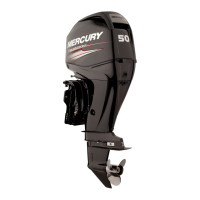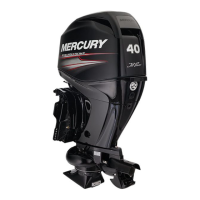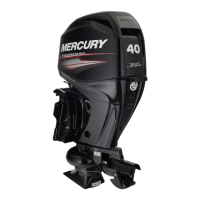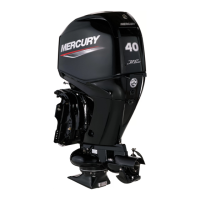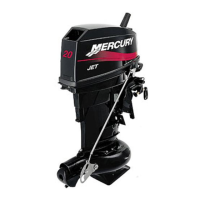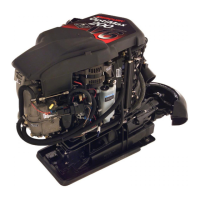1-18 - GENERAL INFORMATION and SPECIFICATIONS 90-817643R1 DECEMBER 1996
4. Start engine and idle in neutral. Then increase engine
speed, not to exceed 2500 RPM.
5. Flush or service engine as required. Be sure adequate
cooling water is provided.
a. Water must be discharged thru “tell-tale outlet.”
IMPORTANT: Prevent engine overheating. If water flow
is insufficient, stop engine and determine cause be-
fore continuing.
b. Flush until discharged water is clear. In saltwater
areas, run outboard 3 to 5 minutes.
c. Stop engine before turning off water.
6. Stop engine, turn water off and remove flushing attach-
ment from gear housing.
IMPORTANT: While and after flushing, keep outboard
in upright position until all water has drained from
drive shaft housing to prevent water from entering the
powerhead via drive shaft housing and exhaust ports.
Following Complete Submersion
Submerged engine treatment is divided into 3 distinct
problem areas. The most critical is submersion in salt
water; the second is submersion while running.
SALT WATER SUBMERSION (SPECIAL
INSTRUCTIONS)
Due to the corrosive effect of salt water on internal engine
components, complete disassembly is necessary before
any attempt is made to start the engine.
SUBMERGED WHILE RUNNING (SPECIAL
INSTRUCTIONS)
When an engine is submerged while running, the possibil-
ity of internal engine damage is greatly increased. If, after
engine is recovered and with spark plugs removed, engine
fails to rotate freely when turning flywheel, the possibility of
internal damage (bent connecting rod and/or bent crank-
shaft) exists. If this is the case, the powerhead must be
disassembled.
SUBMERGED ENGINE (FRESH WATER)
(PLUS SPECIAL INSTRUCTIONS)
1. Recover engine as quickly as possible.
2. Remove cowling.
3. Flush exterior of outboard with fresh water to remove
mud, weeds, etc. DO NOT attempt to start engine if
sand has entered powerhead, as powerhead will be
severely damaged. Disassemble powerhead if neces-
sary to clean components.
4. Remove spark plugs and get as much water as possi-
ble out of powerhead. Most water can be eliminated by
placing engine in a horizontal position (with spark plug
holes down) and rotating flywheel.
5. Pour alcohol into carburetor throat (alcohol will absorb
water). Again rotate flywheel.
6. Turn engine over and pour alcohol into spark plug
openings and again rotate flywheel.
7. Turn engine over (place spark plug openings down)
and pour engine oil into throats of carburetors while
rotating flywheel to distribute oil throughout crankcase.
8. Again turn engine over and pour approximately one
teaspoon of engine oil into each spark plug opening.
Again rotate flywheel to distribute oil in cylinders.
9. Remove and clean carburetors and fuel pump assem-
bly.
10. Reinstall spark plugs, carburetors and fuel pump.
11. Attempt to start engine, using a fresh fuel source. If
engine starts, it should be run for at least one hour to
eliminate any water in engine.
12. If engine fails to start, determine cause (fuel, electrical
or mechanical). Engine should be run within 2 hours
after recovery of outboard from water, as serious inter-
nal damage may occur. If unable to start engine in this
period, disassemble engine and clean all parts and
apply oil as soon as possible.
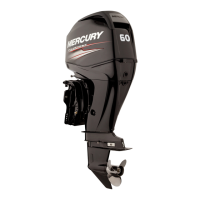
